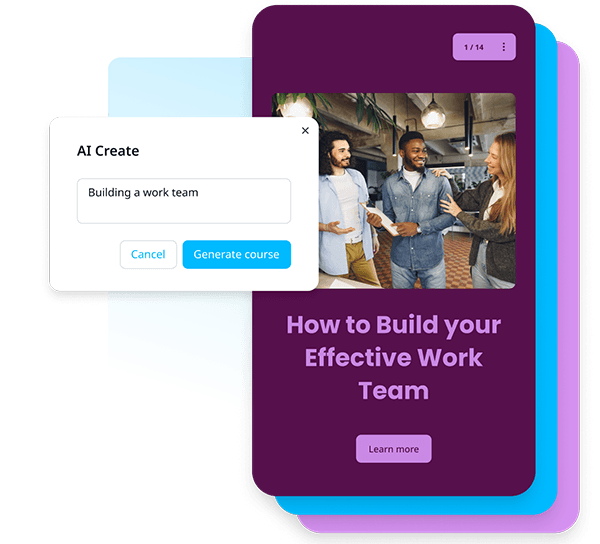How to create a training manual: A step-by-step guide

A training manual is a valuable tool used by organizations to facilitate employee onboarding, skills development, and process standardization. It serves as a reference guide that provides step-by-step instructions, relevant information, and essential resources to enhance the learning experience.
In this article, we'll delve into what a training manual is, its purpose, and the key elements to create an effective and comprehensive training manual.
What is a training manual?
A training manual is a written document designed to guide individuals through the process of learning new skills, tasks, or procedures. It can be used in various contexts, such as employee training, customer support, and educational settings.

Training manuals are commonly used to guarantee consistency in training and to help learners progress at their own pace. They can be physical, digital, or a combination of both, and they serve as a valuable resource for learners long after the initial training has taken place.
What is the purpose of a training manual?
Training manuals help organizations with not just one purpose but a variety of different objectives. Here, we’ll dive into a few of them.
Standardization
One of the primary purposes of a training manual is to establish consistency in the training process. By offering a structured and standardized approach, organizations can make sure that all employees receive the same level of information and training.
Knowledge retention
A well-structured training manual helps learners retain information better. It serves as a reference guide, allowing employees to review concepts and procedures whenever needed, which reinforces their learning and reduces the need for constant retraining.

Time and cost-efficiency
A comprehensive training manual reduces the time and resources required to train new employees or upskill existing ones. It minimizes the need for instructors to repeatedly deliver the same content and allows them to focus on more advanced or specific aspects of the training.
Independent learning
Training manuals allow self-paced learning. Employees can review the content at their own convenience, promoting independent learning and reducing dependency on trainers for every question or concern.

Onboarding and orientation
New hires can benefit significantly from a well-structured training manual during the onboarding process. It helps them acclimate to their roles quickly and become productive members of the team.

Essential elements of a training manual
If you're scratching your head, unsure of what to put in and what to exclude from your training manual, worry not! In this section, we'll explore eight important elements that make an effective training manual.
1. Introduction and Overview
The introduction sets the stage for the training manual. It should give an overview of the training program, its objectives, and the target audience. Additionally, it can include a brief description of the organization and its values to help employees understand how their roles contribute to the company's success.
2. Learning Objectives
Clearly defined learning objectives are essential in a training manual. These objectives outline what learners are expected to know or accomplish after completing the training. Well-crafted learning objectives help learners understand the purpose and relevance of the training, keeping them focused and motivated throughout the process.
3. Training Content
The core of the training manual is the training content. This section should be organized logically, with topics and sub-topics presented in a structured manner. Use headings, bullet points, and numbered lists to make the content easily scannable and digestible. Each topic should be thorough but concise, providing all the necessary information without overwhelming the learners.
4. Visuals and Multimedia
Including visuals such as images, diagrams, and infographics can enhance the training manual's effectiveness. Visuals make complex concepts more accessible and aid in memory retention. Moreover, using multimedia elements like videos or interactive exercises can create a more engaging learning experience.
5. Step-by-Step Instructions
Step-by-step instructions are crucial, especially when training employees on specific tasks or procedures. Clear and detailed instructions help learners follow the process accurately and avoid errors. If applicable, include screenshots or illustrations to further illustrate the steps.
6. Real-World Examples or Case Studies
Incorporating real-world examples and case studies can contextualize the training and demonstrate the practical application of the concepts. Learners can better grasp how the training relates to their daily work, making it more meaningful and relevant.
7. Assessments and Quizzes
To gauge the effectiveness of the training, consider adding assessments and quizzes at the end of each section or module. This allows learners to test their understanding and retention of the material. Feedback on their performance can help identify areas that require further clarification or review.
8. Glossary and References
A glossary of key terms and references to additional resources can be valuable in a training manual. The glossary ensures a consistent understanding of essential terminology, while references provide learners with avenues for further exploration and self-directed learning.
Steps to create a training manual
So, you want to get started on creating a training manual, but you're not quite sure where to start? Don't worry, we've got you covered! Let's break it down into easy steps.
Step 1: Know your audience
First things first, figure out who you're writing for. Understanding your audience is key to crafting a manual that hits the bullseye. Ask yourself questions like who your readers are, why they're reading the manual, and what level of knowledge they already have. This info will help you tailor the content perfectly for them.

Step 2: Map out your content
Now that you know your audience, it's time to plan your content. Organize your topics in a way that makes sense for your readers. You can group them by difficulty level, product features, or popularity with your target demographic. Don't forget to add cool visuals like charts, graphs, and quizzes to make things more engaging!

Step 3: Choose the format
Next up, decide how you want to present your training manual. You can go old-school with printed guidebooks, or maybe you prefer digital formats like PDFs or PowerPoint presentations. It all depends on what you're teaching and how you think your readers will benefit the most.

Step 4: Build the content
Now comes the fun part! It's time to bring all your research and ideas together and create your comprehensive training manual. Depending on your resources and goals, this could be a simple text document or a fancy interactive module. Remember, the key is to make it as helpful as possible for your audience.
EdApp is a great online training platform that can help you create your free training manuals with ease. One of its best features is its intuitive Creator Tool. With this feature, bringing your training vision to life is a piece of cake! All you have to do is choose a template, drag and drop your content, hit publish, and you're good to go. It's really that easy!

You can also take advantage of EdApp’s newest AI-powered authoring feature called AI Create. With this, there’s no more need to stress about starting a course from scratch. Create microlearning courses with your very own brainstorming buddy that's never short of brilliant ideas. All you have to do is add your prompt, click create, and like magic, you'll have lessons, slides, and interactive content right at your fingertips.

Step 5: Share and gather feedback
Once your training manual is ready, share it with your team or audience. But hold on, the job's not done yet! Be proactive and collect feedback from your readers. It could be through surveys or support channels. This feedback will help you spot areas for improvement and measure the manual's effectiveness.

Step 6: Keep your content fresh
Don't forget that nothing stays the same forever! As systems and products evolve, your training manual should too. Regularly review and update the content to keep it relevant and valuable for your audience.

Creating an effective training manual requires careful planning, organization, and attention to detail. When done right, a training manual can significantly contribute to the success of an organization by fostering consistent training practices, increasing knowledge retention, and promoting independent learning among employees.
By incorporating the right elements and design, organizations can ensure their training manuals become invaluable resources for employees throughout their careers. With this guide, you'll be well on your way to creating a top-notch training manual that makes learning a breeze.
Join EdApp today and start creating your training manuals for free!
Author
Hannah Malmstrom
Hannah is an eLearning writer who dedicates her time to creating in-depth content about EdApp, a multi-award-winning mobile LMS that has pioneered one of the most progressive microlearning solutions on the market. She brings years of writing experience in the online software industry to her current role in the eLearning sphere. When she's not writing, you can find her catching up on new anime series or re-reading her favorite novels.
